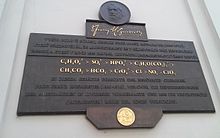Hofmeister series
The Hofmeister series (also Hofmeister series or Lyotrope series ) describes the different precipitation effects of salts . In 1888, the chemist Franz Hofmeister investigated the protein-precipitating effect of salts and thus of the ions dissolved in water . He empirically found ion sequences that characterize the strength of the influence on the biomolecules dissolved in water.
Lyotropic series
The Hofmeister series is used to classify the chaotropic effect of ions on macromolecules in aqueous solution and is given below for anions and cations:
Anions:
Cations:
In the given Hofmeister series, the chaotropic, i.e. H. structure-breaking effect of the ions mentioned from left to right. The ions further to the left ( antichao- or kosmotropic ), on the other hand, act as structure-maintaining, gentle precipitants . They intensify the hydrophobic effects in aqueous protein solutions and thereby promote protein aggregations through hydrophobic interactions. This leads to the failure of proteins while largely maintaining the tertiary structure. This fact is used when salting out. The ( chaotropic ) ions further to the right lead to the denaturing precipitation of proteins. Mechanistically, the chaotropic effect has not been conclusively clarified. Presumably, the reduction in the hydrophobic interactions occurs by increasing the disorder between the surrounding water molecules. The viscosity of the water decreases. The chaotropic salts increase the solubility of hydrophobic molecules in water and one speaks of salting .
An example: water and fatty oils do not mix. The liquids remain separate from one another as a result of the hydrophobic effect . Chaotropic salts reduce this effect. They disrupt the hydrophobic forces that keep the proteins in their tertiary or quaternary structure and denature them. Chaotropic salts abolish the strict separation of water and fats, they "stabilize" hydrophobic particles or hydrophobic groups of molecules in water. NMR relaxation studies showed that z. B. large chaotropic anions such as bromide (Br - ) and iodide (I - ) attach to hydrophobic particles or groups of molecules and thus create polar spots on their surface, which then makes the overall molecular system more soluble in water and causes the salt effect. Theoretically, the Hofmeister series is not yet fully understood; the main effects are based on a very complex interplay of interactions between the ions, the solvent water and the dissolved organic molecules. It is noticeable that the chaotropic effect increases with the ionic radius in the case of monatomic anions, whereas it decreases in the case of monatomic cations. Experimentally, it was also found that the Hofmeister series is not only valid for macromolecules dissolved in water, but also describes the ionic effect on hydrophobic effects in the case of small, non-polar particles or groups of molecules.
Applications
In practice, chemists often use perchlorates , thiocyanates or barium salts as chaotropic salts . Protein purification should be mentioned as an application of the knowledge from the Hofmeister series , just as this knowledge plays an important role in biochemical analysis, namely in hydrophobic interaction chromatography . In medicine, the Hofmeister series are also important for the effects of diuresis .
The salting out of glycerol with sodium chloride is used in soap production and is one of the oldest technical applications of precipitation, along with the precipitation of tofu with gypsum .
Biotechnologically produced recombinant proteins are occasionally by an ammonium sulfate precipitation concentrated. In biochemistry , guanidinium thiocyanate is used for the denaturing solubilization of hydrophobic proteins , for example in the purification of DNA or RNA .
Salt effects are also expected to provide approaches to the therapy of protein misfolding diseases such as Alzheimer's disease , amyotrophic lateral sclerosis , BSE and similar diseases, where aggregates of proteins are important. It succeeded z. B. to dissolve protein clumps by adding certain salts. In a study on the same problem, it was found that antichaotropic salts (e.g. ammonium sulfate) used to precipitate proteins in a solution can subsequently lead to the denaturation of high molecular weight metalloproteins in the same solution. The stability of the metal ion-protein bond, which also influences the properties of a metalloprotein in solution, is reflected in the Irving-Williams series .
literature
- Y. Zhang, PS Cremer: Interactions between macromolecules and ions: The Hofmeister series . In: Current Opinion in Chemical Biology . tape 10 , no. 6 , 2006, p. 658-663 , doi : 10.1016 / j.cbpa.2006.09.020 .
Individual evidence
- ↑ Franz Hofmeister: On the doctrine of the effect of salts: second communication . In: Archives for pathological anatomy and pathology (1888), Volume 24, pp. 247-260.
- ↑ Robert A Horton, Laurence A. Moran, Gray Scrimgeour, Marc Perry, David Rawn ,: Biochemie. Pearson Deutschland GmbH, 2008, ISBN 978-3-827-37312-0 , p. 47 ( limited preview in the Google book search).
- ^ Helmut Günzler: Analytiker-Taschenbuch. Springer-Verlag, 2013, ISBN 978-3-642-79262-5 , p. 69.
- ↑ D. Voet & J. Voet: Biochemistry , 3rd edition 2004, Wiley-Verlag, p. 265.
- ↑ M. Holz (1995): Nuclear Magnetic Relaxation as a Selective Probe of Solute - Solvent and Solute - Solute Interactions in Multi-component Mixtures. In: J. Mol. Liquids , 67, 175-191.
- ^ B. Kastenholz (2007): New hope for the diagnosis and therapy of Alzheimer's disease. In: Protein Pept. Lett. Vol. 14, pp. 389-393.
- ↑ CL Dupont, A. Butcher, RE Valas, PE Bourne, G. Caetano-Anollése (2010): History of biological metal utilization inferred through phylogenomic analysis of protein structures. In: Proc. Natl. Acad. Sci. USA Vol. 107, pp. 10567-10572.



